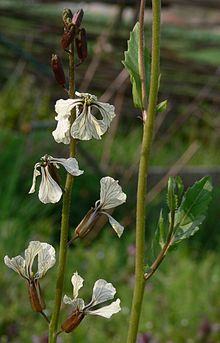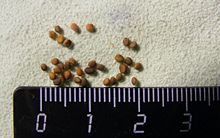Garden Senfrauke
| Garden Senfrauke | ||||||||||||
|---|---|---|---|---|---|---|---|---|---|---|---|---|

Garden Senfrauke |
||||||||||||
| Systematics | ||||||||||||
|
||||||||||||
| Scientific name | ||||||||||||
| Eruca vesicaria subsp. sativa | ||||||||||||
| ( Mill. ) Thell. |
The garden mustard ( Eruca vesicaria subsp. Sativa ) is a subspecies of the mustard ( Eruca vesicaria ), a species of the cruciferous family (Brassicaceae). It is used under the name of arugula for consumption in salads.
description
Vegetative characteristics
The garden mustard grows as an annual (to two-year) herbaceous plant and reaches heights of 15 to 50 centimeters. The upright stem is usually branched, angularly striped and, at least in the lower part, ruffled, rarely also very little hairy.
The stem leaves are alternate and are significantly smaller than the basal leaves . The leaf base does not include the stem. The foliage leaves of the Garten-Senfrauke are cupped, pinnate and have two to four pinnate sections on each side, which are mostly entire, but sometimes also toothed. The end of the sheet is formed by a single section that is significantly larger than the side. The leaves are usually bare, occasionally with individual hairs on the leaf surface. When rubbed, they develop an intense smell, which, depending on how you feel, is described as "spicy aromatic" to "strangely unpleasant".
Generative characteristics
The flowers are at the end of the stem and possibly the side branches in a loose, not too floriferous racemose inflorescence . The flower stalks are 3 to 8 millimeters long and thus significantly shorter than the calyx.
The flowering period extends from May to late summer. The hermaphrodite, four-fold flower is a good 1 to 3 centimeters long. The four sepals are dark brown-purple, narrow-egg-shaped and at their blunt end have a sometimes quite indistinct white skin edge. The four nailed petals are white with a yellowish tint and have clear, brown-purple veins.
The pods adjacent to the stem are slightly compressed, 20 to 35 millimeters long and 3 to 5 millimeters thick. At its end there is a 5 to 9 millimeter long, flattened beak. The seeds of the garden mustard have a thousand grain weight of 2 grams.
The number of chromosomes is 2n = 22.
Occurrence
The garden mustard Eruca sativa comes from the Mediterranean area . In Central Europe it is occasionally grown in private gardens and, to a lesser extent, in commercial horticulture as a cultivated plant. From there it is seldom overgrown and then found in ruderal locations (wasteland, roadsides, rubble sites, etc.). Occasionally, it also unintentionally enters fields as a contaminant in seeds. It prefers nutrient-rich sandy or loamy soil. In Central Europe it has so far only grown inconsistently as a wild plant. For Switzerland, “ Flora Helvetica ” is the name of established stocks in the Rhone Valley.
Systematics
The first publication took place in 1768 as a separate species ( Basionym ) Eruca sativa Mill. By Philip Miller . In 1919 she was Albert Thellung as a subspecies Eruca vesicaria subsp. sativa (Mill.) Thell. of Eruca vesicaria (L.) Cav. classified. Another synonym for Eruca vesicaria subsp. sativa (Mill.) Thell. are: Brassica eruca L. , Brassica erucoides Roxb. , Eruca longirostris Uechtr. , Eruca stenocarpa Boiss. & Reut. , Eruca sativa subsp. longirostris (Uechtr.) Jahand. & Maire .
use
The garden senfrauke was already used as food in the Mediterranean region in Roman times and was even regarded as an aphrodisiac .
For use as a lettuce plant ( rocket ), the basal leaves are harvested before the stem sprouts.
In traditional folk medicine , the garden mustard is said to be appetizing and diuretic.
The seeds were and still are used to extract oil. The cultivation of Eruca sativa for this purpose is known from India in particular , but it has no significant economic importance. The oil is mainly used for industrial purposes.
Similar names
The garden mustard Eruca sativa is also often referred to as rocket . This can lead to confusion with the narrow-leaved double seed ( Diplotaxis tenuifolia ), which is also offered under this name. The leaves of Diplotaxis are smaller than those of Eruca , the leaflets are narrower and the terminal leaflets are not as enlarged. Diplotaxis tenuifolia is a wild plant that has become firmly established in Central Europe. It blooms yellow.
Some authors simply refer to the genus Eruca as "rocket". Then, however, there is the problem that the genus name Rauken is already occupied by the yellow flowering cruciferous plants of the genus Sisymbrium, which are more widespread in Central Europe . That is why the genus is named after Schmeil-Fitschen Senfrauken .
Due to the great similarity in spelling and sound, names can be confused between the completely different plants rocket and rue ( rue , ruta graveolens ).
More common names
In the German-speaking area there are a few other names for the garden mustard: Ölrauke, Raukenkohl, Ruke, Rucola, simply Senfrauke or even just rocket. The term "Arugula" comes from the English-speaking world. See also the Similar Names section above .
The other German-language trivial names exist or existed for the Garten-Senfrauke : Ernockel ( Middle High German ), Eruckh (Middle High German), Gerheb (Middle High German), Gernol (Middle High German), Irich (Middle High German), Roman Kole (Middle High German), Rauke, Rockelen, Roquelen (Middle High German) and weis zam Senff.
swell
- Dietmar Aichele, Heinz-Werner Schwegler: The flowering plants of Central Europe. Volume 3: Evening primrose plants to reddish plants. Franckh-Kosmos, Stuttgart 2000, ISBN 3-440-08048-X .
- Bavarian State Institute for Viticulture and Horticulture (Ed.): Rucola - the rocket. An old cultivated plant with a Mediterranean flair. In: Bayerische Gartenakademie: Merkblatt Volume 2168, pp. 1–2, PDF file, 79 kB.
Individual evidence
- ^ Erich Oberdorfer : Plant-sociological excursion flora for Germany and neighboring areas. 8th edition. Verlag Eugen Ulmer, Stuttgart 2001, ISBN 3-8001-3131-5 . Page 440.
- ↑ Eruca vesicaria sativa at Tropicos.org. Missouri Botanical Garden, St. Louis, accessed October 24, 2015.
- ↑ Eruca vesicaria subsp. sativa in the Germplasm Resources Information Network (GRIN), USDA , ARS , National Genetic Resources Program. National Germplasm Resources Laboratory, Beltsville, Maryland. Retrieved October 24, 2015.
- ↑ Pedanios Dioscurides: Materia Medica. 1st century, PDF file, search for "Rauke". ( Memento of the original from September 24, 2015 in the Internet Archive ) Info: The archive link was inserted automatically and has not yet been checked. Please check the original and archive link according to the instructions and then remove this notice.
- ↑ Otto Schmeil , Jost Fitschen (start); Werner Rauh, Karlheinz Senghas: Flora of Germany and its adjacent areas. 84th edition. Quelle & Meyer, Heidelberg 1968.
- ^ Georg August Pritzel , Carl Jessen : The German folk names of plants. New contribution to the German linguistic treasure. Philipp Cohen, Hannover 1882, page 145. ( online ).
further reading
- S. Padulosi, D. Pignone (Eds.): Rocket: a Mediterranean crop for the world. Report of a workshop, December 13-14, 1996, Legnaro (Padova), Italy. International Plant Genetic Resources Institute, Rome, Italy 1997, ISBN 92-9043-337-X . PDF file, 1.93 MB .
Web links
- Eruca vesicaria sativa at Plants For A Future . Retrieved September 11, 2012.
- Eruca sativa Mill., Senfrauke. In: FloraWeb.de.
- Distribution map for Germany. In: Floraweb .
- Eruca sativa Mill. In: Info Flora , the national data and information center for Swiss flora . Retrieved October 24, 2015.






